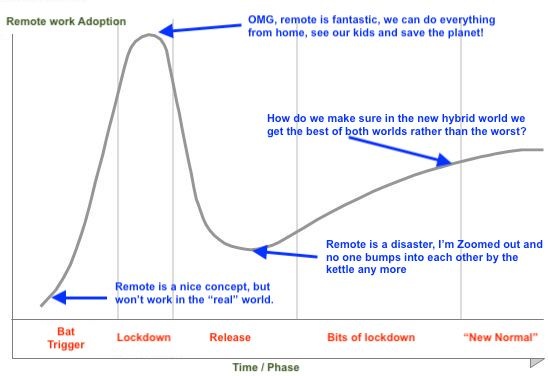The hype told us that working remotely was all good – less commuting, more family time, greener planet. And the valley of despair told us it was lonely, stopped “water cooler” moments, and killed culture. ~ Iyas AlQasem

After the hype, comes the disillusionment. Some people are losing faith with remote work.
Employee fatigue and burnout was a wellbeing concern for many employers before the pandemic. Eight months in, the problem seems to have been exacerbated by granting people the very thing they coveted the most: unlimited flexibility.
Are we experiencing the unintended consequences of what was a sudden shift to working remotely?
Data from Gallup reveals something that’s never been seen before: fully remote workers are now experiencing more burnout than on-site workers. Before the pandemic, the perks of working remotely — either part of the time or all the time — resulted in lower levels of burnout compared with employees who were on-site 100% of the time. The situation has flipped.
On one hand, we shouldn’t panic. Let’s remember we are taking part in a massive unplanned experiment in remote work at scale and the use of technology in the workplace. Even the very best planned experiments go wrong. This was never going to work at our first attempt. We are going to learn some things do not work well at all, but we are also going to find many that do.
So let’s accept that working life has changed for good, regardless of if and when COVID-19 will be brought under control. We’ll never go back to the way we were and our focus should shift to what the minimum office looks like and how best employers can support best practices around it.
As Michael Y. Lee and Koen Veltman write , the Covid-19 pandemic is perhaps the greatest threat to team connectedness we have ever seen. However their research indicates a workplace divide between those thriving and those burning out. They find that 45% of people said their team’s level of connectedness had declined since Covid-19, but nearly one-third said it had improved. Only about one in five reported no change. The pandemic, far from having a consistent effect observable across the sample, had created a divide. Teams that seemed better adjusted to the “new normal” were becoming more connected as a result, while those that adapted less saw the quality of their relationships decline. They conclude that harnessing the power of new technologies, designing new interaction rituals and leveraging the pandemic as an opportunity to show compassion and care are good places to start.
This diversity of experience presents both a problem and an opportunity. As Leisa Reichelt writes for Atlassian everyone is experiencing working from home entirely differently, and she surmises that its based on three basic factors:
- Household complexity – The magnitude of care duties people have responsibility for, as well as the density of their household, affects their remote working experience.
- Role complexity – The complexity of an employee’s workflow, and the level of social interaction they depend on to be successful in their role, influences their job success & satisfaction.
- Network quality – People’s access to personal and workplace communities contributes to a person’s sense of belonging, and support.
These are important factors that we need to address on an individual level rather than with one-size-fits-no-one wellbeing initiatives.
There are a couple of other emerging problems:
The Problem With Management:
Little has changed in the fundamental way we work. We’ve lifted and shifted legacy office ways of working to the home. We’ve not changed enough other stuff. Much management coordination activity continues to be focussed on replicating pre-existing processes, methods and rituals, but using digital tools, which is even easier when remote and there’s zero commute time. This means working hours have increased, some suggest by 10 hours a week.
Additionally we’re spending more time than ever reporting, trying to make our work visible to those around us. This spike in ‘work about work’ is at best self-indulgent and at worst, a complete waste of people’s time.

The Problem With Personal Planning:
A lot of office workers have never really had to think about planning and productivity. The 9-5, for all its many flaws, has provided a monotonous but convenient template for us all to follow for generations.
You get up, you shower, you put on work clothes, and you commute to work. You put a shift in and you leave. Rinse and repeat.
The demarcation line between work and personal life has disappeared entirely. In addition, given the ease with which digital tools lend themselves to constant communication means we can exist in a constant state of distraction where deep work becomes impossible.
This is my real fear – that we focus on low grade menial ‘tasks’ and work about work rather than deep work solving the problems that truly matter.
Let’s go back to how I opened. This is an experiment. We don’t have to beat ourselves up – yet.
However , eight months in we need to pick apart what works and what doesn’t pretty damn quickly. When running innovation experiments you have to iterate very quickly before erroneous results form into established behaviours.
Related:
As our experiment goes on longer the more it becomes a normal way of working. 18 months in and we’ll find our new way of working becomes impossible to change.
The time to call out the problems and test some solutions is now. Let’s look at the third of people who are thriving in a remote work environment. What are they doing that works and how can we build upon that?
A series of radical experiments with your team would be a far better use of that 10 hours extra a week we are working than yet another Teams/Zoom Doom session.


